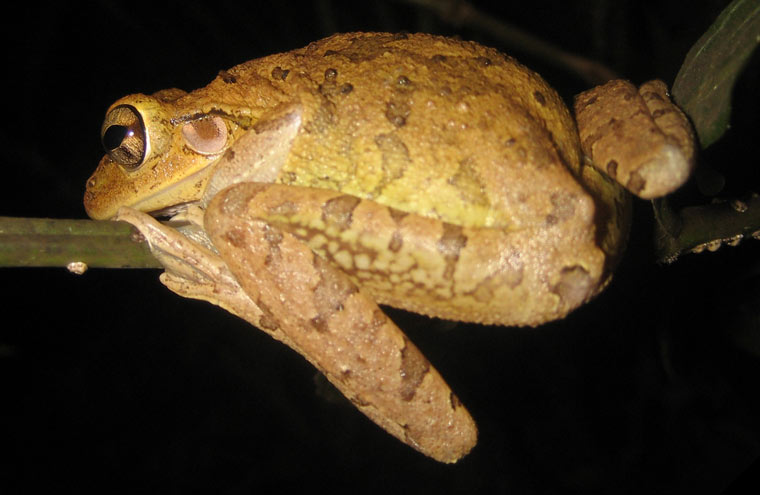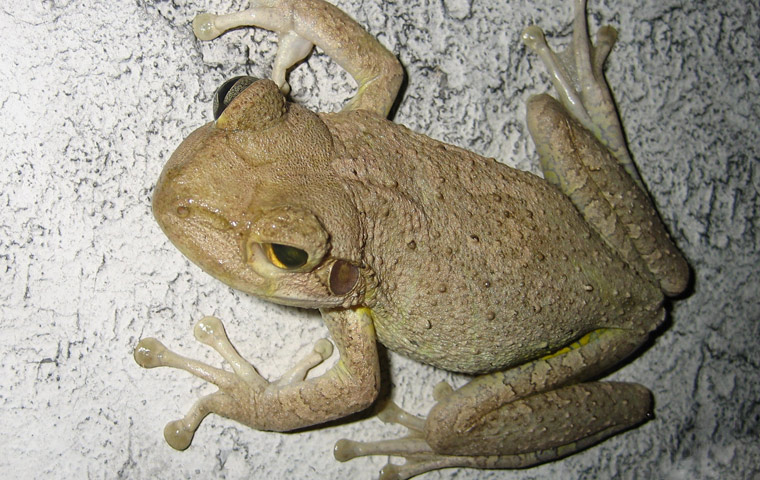-
info@aaanimalcontrol.com
Call us for help in your town
Humane Wildlife Education
Thinngs to know about Cuban tree frogs in Florida
Need frog removal in your hometown? We service over 500 USA locations! Click here to hire us in your town and check prices - updated for year 2020.
A species of animal that has found its way to the shores of the United States because they have been brought by people is the Cuban tree frog. This is becoming a common animal in Florida because of how successfully they have been able to adapt to the area, which is very much like that of Cuba.

This frog is the largest of all of these amphibians that you will find in North America, and has such a large diet in terms of the kinds of foods that it will eat that it has made it easily able to adapt to the continental United States.
This frog can range from about 3 inches to 5.5. This makes it the largest tree frog in North America. The skin is quite warty and rough, and you will often see an orange tint in the eyes of this frog. The skin color itself can range from brown, to olive, to bronze, to gray. You are likely to even see some white in the skin of these frogs.
The Cuban tree frog is an excellent climber and will sleep inside a tree during the daytime. At night, they forage around the ground looking for insects and other sources of food. The most common kinds of foods that these frogs will eat are such things as snails, spiders, and other insects, but they are also known to eat other frogs, snakes, crustaceans, lizards, and even birds. There seems to be no limitation to the different foods that they will eat.
In this species of frog, the females are larger than the males. Cuban frogs are able to breed all year long, with the most common months being May and October. The reason why these months are so common is because they are the wettest months of the year. This makes it conducive to the lifecycle of the Cuban tree frog.
While being native to Cuba, they have found themselves onto islands of the Bahamas, the Cayman Islands, the US Virgin Islands, the British Virgin Islands, and Puerto Rico. They have even been found in some areas quite far away from Cuba, including Hawaii, and are now working their way along the Gulf Coast and the Atlantic Ocean, reaching Alabama, Mississippi, and South Carolina.
How they have been able to disperse themselves across a wider range of the earth has occurred because of their ability to hijack their way in potted plants or other vegetation that has been brought from the Cuban island. Because of the fact that they are able to breed year-round and eat a great diversity of food, it is been easy for them to thrive and acclimate themselves to new areas where they arrive.
Because of the large numbers of different kinds of foods that they will eat, they are harming ecosystems in some locations because they easily wipe out smaller amphibians and reptiles as well as insect populations. It is very likely that in a short period of time that this could become the dominant frog of North America.
Cuban Tree Frogs in Florida
Need wildlife removal in your hometown? We service over 500 USA locations! Click here to hire us in your town and check prices- updated for year 2020.
The name gives the game away as far as the Cuban tree frog is concerned. It is a frog that originally lived in Cuba and also the Bahamas, but has since found home in other habitats, including Florida. Osteopilus septentrionalis is the official and technical name for the frog, although we'll forgive you if you don't remember it. The other thing that you should know about this species of frog, is that it is a pest. An invasive pest at that.

Cuban tree frogs were believed to have been introduced to Florida at some point in the 1920s, more than likely on board cargo ships that carried exotic foods and other things from continent to continent. The reason they have been give the name ‘invasive pest' is because they have an adverse effect on the wildlife that already thrives and belongs in Florida. There are a number of native frogs that Cuban tree frogs in Florida prey on, and five of those species are becoming directly affected as a result of the pest's introduction. Not only that, Cuban tree frogs are also making life harder for the other animals to survive, because there is a constant and ever-growing battle for shelter, food and water.
It's turning into a frog-eat-frog world out there ...
What do Cuban tree frogs in Florida look like?
This is where life gets tough, because the Cuban tree frog can actually look very different from frog to frog. Some are green, whereas others have a more brown appearance. They also be grey and an off-white color, and they can even rock a wide range of splodges, spots, blotches and stripes too. Some are one solid color, others are a clever and intricate mix of everything ... The Cuban tree frog could almost be the perfect master in disguise. They are often confused with many other native frog species, in fact.
Where will you find Cuban tree frogs in Florida?
These invasive frogs are starting to pose just as much of a problem for homeowners as they are for other native animal species, mostly because they have survived very well in Florida, with its subtropical climate. Their populations are thriving, with plenty of food around, and now plenty of other Cuban tree frogs to mate with too.
Homeowners often report Cuban tree frogs close to houses, particularly when the lights are on, and this is more than likely due to the insects the light attracts. Anywhere with water can be affected too, with bird feeders becoming frog swimming pools, and even drains becoming victims. Some frogs have even managed to get into human homes. Once inside, they can clog up drains and cause contamination problems. They have even been known to play havoc with utilities. These frogs can grow to some size, and they can short-circuit larger electrical systems. That's another thing that makes them a nuisance in Florida – they grow much larger than most other native species of frog, and these native species do not seem to pose human habitats the same problems.
What to do if you find Cuban tree frogs in Florida
You more than likely won't know that you have found a Cuban tree frog. As we have already discussed, this is a frog that has a number of different appearances, and unless you've found yourself a rather large one, there's a good chance you'll confuse the species with another, native one.
These frog species should be reported and captured, where possible. They secret a slime when threatened, and this can play havoc with the eyes and respiratory system in humans and other animals, and that's why you should never try to handle any frogs (or similar species) without wearing gloves and other forms of protection. This is even more so the case with those who suffer from asthma. The slime secreted by Cuban tree frogs has been known to agitate asthma greatly.
We would always recommend that you call in a professional when dealing with wildlife in your home or on your land, and that's definitely the case with the Cuban free frog, or other species of frogs that you are unable to identify. If you can't be sure what species you have in front of you, you shouldn't attempt to handle it. The other thing that you will need to bear in mind is the relocation of trapped animals. In the case of these Cuban-born frogs, it is unlawful to release them back into the wild again. Unless they are taken to special captivation and conservation places, invasive creatures, such as Cuban tree frogs, must be destroyed after they have been caught. Sadly, this is the only way to deal with invasive animals to prevent the native creatures from suffering as a result of the introduction.
For more information, you may want to click on one of these guides that I wrote:
How To Guide: Who should I hire? - What questions to ask, to look for, who NOT to hire.
How To Guide: do it yourself! - Advice on saving money by doing wildlife removal yourself.
Guide: How much does wildlife removal cost? - Analysis of wildlife control prices.
Animals in the attic - read about the common species.
Noises in the attic - how to identify critters by their sounds.


















